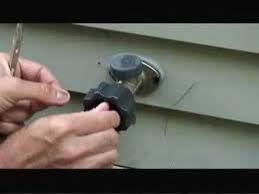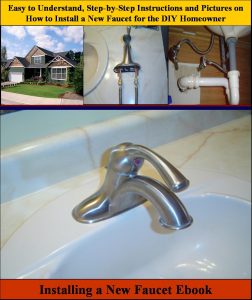Step-by-Step Instructions for installing an Outdoor Faucet / Sillcock
By Mark J. Donovan
|
|
If you live in a cold climate area, and have older outdoor faucets, it is important to make sure you turn the line stop valves off during the cold months. The line stop valves enable the water to flow to your outdoor faucets and usually sit a few inches back inside your home. With these valves turned off you can then turn on the outdoor faucets and allow them to drain and remain open during the winter months.
An alternative to older outdoor faucet models is the frost free outdoor faucet or sillcock. |
Remove Existing Outdoor Faucet
To install a frost free outdoor faucet, start by turning off the line stop valve to the outdoor faucet and draining the water from the pipe and existing faucet.
Leave the outdoor faucet in the on position after the water drains out.
Next remove the screws that hold the existing faucet to the home.
| Now, from inside the home, measure back the length of the exiting outdoor faucet pipe plus 3-4 more inches and mark the pipe. This mark should sit between the line stop valve within the home and the interior wall surface.
Place a bucket underneath your pencil mark. Using a hacksaw or pipe cutter, cut the pipe where you marked it. Go outside the home and pull the existing outdoor faucet from the exterior wall. |
 |
Install New Frost Free Outdoor Faucet
Now slide your new sillcock unit into the hole and measure the gap from the end of the sillcock’s pipe to the end of the supply line. You will need this measurement to calculate a new piece of copper pipe to tie the sillcock to the supply line.
When measuring the length of filler pipe required, make sure you account for a threaded fitting that will allow the sillcock to screw into the fitting, and a strait fitting to tie the supply line to the sillcock. If you make the small length of copper pipe too long your sillcock will not fit flush up against the exterior of the home. If you make it too short you will not be able to connect the supply line to the sillcock/threaded fitting/short-pipe assembly.
After cutting the small length of filler copper pipe, slide the sillcock into the home and test fit the length of copper pipe and fittings. Make sure they tie together well. Also make sure you have accounted for having to screw the sillcock onto the threaded fitting. This can consume about 1/4th inch of the length of the thread fittings.
Now screw the threaded piping assembly to your sillcock. Use a couple of wrenches to make sure the connection is tight.
Next insert your sillcock assembly into the exterior wall and attach the straight fitting over the end of the supply line.
| Again using a propane torch, solder the straight fitting to the supply line. Again, quickly wipe down the joint with a rag just after soldering it.
Using a couple of screws attach the outdoor faucet to the home. Testing Your Work Finally, turn on the stop line valve and you frost free outdoor faucet / sillcock should be ready to go. Test the sillcock by turning it off and on. Examine your fittings for leaks. If any are found, turn off the stop line valve, turn on the sillcock and drain any water from it. |
|
Examine where the leak is flowing. Once you have found the offending joint, heat it up with your propane torch and disconnect it (don’t burn yourself). Re-clean the joint, apply flux and reflow the joint.
Test the system again and with any luck you have a leak free, frost free outdoor faucet.
For information on installing a shower pan membrane liner for a ceramic tile shower, see the Shower Pan Membrane Liner Installation eBook from HomeAdditionPlus.com. The Shower Pan Membrane Liner EBook will quickly teach you the step-by-step process for installing the shower pan membrane liner correctly. It includes instructions on framing the shower stall, pouring the pre-slope and shower base mortar, and installing the shower pan membrane liner.
For information on how to tile a custom ceramic tile shower, see the “How to Tile a Custom Ceramic Tile Shower eBook” from HomeAdditionPlus.com. This eBook will quickly provide you with step-by-step instructions on how to measure and install ceramic tile in a shower, including the installation of tile on shower walls, floors and curbs. It provides detailed instructions for every step in the process of tiling a custom ceramic tile shower and is loaded with instructional pictures!
Related Information
- How to Fix a Leaky Hose Bib
- How to Resolve a Leaky Outdoor Faucet Problem
- How to Repair Silcock when Leaks from Cap on Top
- How to Fix a Bathroom Sink Stopper that is Not Staying Closed
Additional Plumbing Resources from Amazon.com
 |
 |
Get Free Bathroom Remodeling Price Quotes with No Obligation!
Fill out our 3-5 minute quick and easy form, and receive a free price quote on a bathroom remodeling project from one of our pre-screened and licensed bathroom remodeling contractors. This process is free and there is no obligation to continue once you receive your bathroom addition price estimate.

